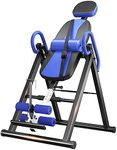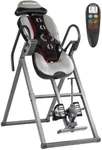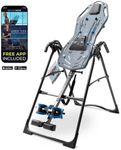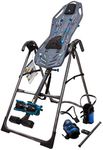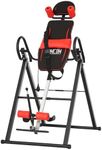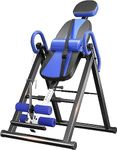Buying Guide for the Best Inversion Tables
Inversion tables are a popular tool for those seeking relief from back pain, improving flexibility, or simply looking to enhance their overall wellness routine. The idea is to use gravity to decompress the spine, which can help alleviate pressure on the discs and nerves. When choosing an inversion table, it's important to consider several key specifications to ensure you select a model that best fits your needs and provides a safe and effective experience.Weight CapacityWeight capacity refers to the maximum weight the inversion table can safely support. This is crucial for ensuring the stability and safety of the user during inversion. Inversion tables typically have weight capacities ranging from 250 to 350 pounds. It's important to choose a table that can comfortably support your weight, with some extra margin for safety. If you're close to the upper limit of a table's capacity, consider opting for a model with a higher weight limit to ensure durability and safety.
Height RangeThe height range of an inversion table indicates the range of user heights it can accommodate. This is important for ensuring that the table can be adjusted to fit your body properly, which is essential for effective and safe inversion. Most tables can accommodate users from about 4'10" to 6'6". To choose the right one, ensure that your height falls within the specified range of the table. Proper height adjustment is key to achieving the correct balance and inversion angle.
Inversion AngleInversion angle refers to the degree to which the table can tilt. This is important because different angles can provide varying levels of decompression and comfort. Common angles include 20, 40, 60, and 90 degrees. Beginners might start with a lower angle to get used to the sensation, while more experienced users might prefer a full 90-degree inversion for maximum decompression. Consider your comfort level and any medical advice when choosing the inversion angle.
Safety FeaturesSafety features on an inversion table can include things like secure ankle locks, sturdy frames, and safety straps or handles. These features are crucial for ensuring that you can use the table safely and confidently. Look for models with easy-to-use and comfortable ankle locking systems, as well as robust construction. If you're new to inversion therapy, additional safety features like safety straps that limit the inversion angle can be beneficial.
Comfort FeaturesComfort features include padded backrests, ergonomic designs, and adjustable headrests. These are important for ensuring a pleasant and comfortable inversion experience, especially if you plan to use the table frequently. Look for tables with thick, comfortable padding and ergonomic designs that support your body. Adjustable headrests can also enhance comfort by providing proper neck support. Consider how long you plan to use the table in each session and choose comfort features that will support that duration.
Portability and StoragePortability and storage refer to how easy it is to move and store the inversion table when not in use. This is important if you have limited space or plan to move the table frequently. Some tables are foldable, making them easier to store in a closet or under a bed. Consider the weight and foldability of the table if space is a concern. If you need to move the table often, look for models with wheels or lightweight designs.

